Study on the Dynamic Response and Tension Characteristics of a TLP with One Tendon Broken
GU Jia-yang,CHEN Yu,GENG Pei-teng,LIU Wei-min
(School of Naval Architecture and Marine Engineering,Jiangsu University of Science and Technology,Zhenjiang 212003,china)
Study on the Dynamic Response and Tension Characteristics of a TLP with One Tendon Broken
GU Jia-yang,CHEN Yu,GENG Pei-teng,LIU Wei-min
(School of Naval Architecture and Marine Engineering,Jiangsu University of Science and Technology,Zhenjiang 212003,china)
As a type of semi-compliant and semi-fixed platform,the Tension Leg Platform(TLP)has a special vertical mooring system.The key of the design is the coupled dynamic response of platform,mooring system and risers,which directly affects the safety and reliability of the platform.This paper compares the motion response and mooring characteristics of a TLP in 500 m underwater by the methods of numerical simulation and model test.The model test was carried out in the State Key Laboratory of Ocean Engineering of Shanghai Jiao Tong University with scaling factor model test 1:40.The numerical calculation is conducted by the SESAM software from DNV.The results from the numerical simulation appear similar with that from the model test,verifying its reliability.Furthermore,the hydrodynamic characteristics of a TLP with one tendon broken are investigated in detail, focusing on the influences of significant wave height,significant period and wave approach angle on the six-degree-of-freedom motion responses and tension in tendons of the TLP.
TLP;coupled response;one tendon disconnection;mooring characteristics
0 Introduction
Tension Leg Platform(TLP)is a kind of semi-compliant and semi-fixed platform with a vertical mooring system.The platform includes four parts:floating superstructure,mooring system(tendons),foundation and risers.The floating superstructure is consisting of the hull and the upper deck,and the hull is composed of columns and pontoons.The tendons are typically constructed by many groups of taut steel cables,and the number of groups relies on the shape of the superstructure.Each group of cables is composed of a plurality of cables or steelbeams.One end of the leg is fixed in the foundation piled into the seabed,and the other end is connected to a tense winch within the floating superstructure.The tension leg system not only determines the relative position of the wellhead and the platform,but also plays a decisive role in keeping its security.
Due to the complexity of model test and the restrictions of test conditions,the model tests for dynamic response and mooring characteristics of TLP are rare in China.Most of the researches on motion response of TLP are based on time domain analysis.Ahmad et al[1]studied the coupled response of TLP in random wave,considering the nonlinear effect caused by the coupling of the drag force,variable tension,variable draft,offset and wind load.Chandrasekaran et al[2]studied the dynamic response of the triangular TLP under random wave,carried out spectrum analyses of the six-degrees-of-freedom motion response,considering the impact of fluid-solid coupling,variable draft and flow.Tabeshpour et al[3]conducted nonlinear dynamic analysis on the TLP in both time domain and frequency domain.Zeng et al[4]studied the motion response of TLP with tendons in tight or slack state by numerical simulation,and the results showed that:compared to the varying stiffness of tendons,the varying weight of the platform is more likely to cause tendons slack,and larger wave height would give rise the relaxation of tendons as well.Senjanovic et al[5]proposed a new stiffness matrix to simulate the dynamic response of TLP,describing the motion of the TLP in the horizontal plane very well, and considering the TLP as a rigid body mounted with flexible mooring system.Yang et al[6]studied transient dynamic response of an ETLP during harsh environmental conditions of Gulf of Mexico(GoM)by numerical simulation.This ETLP has twelve tendons with twelve top-tensioned risers(TTRs)and one drill conductor.Using a time-domain nonlinear global-motionanalysis program,the transient dynamic response of a TLP coupled with floating hulls,risers and mooring lines was numerically calculated,with one tendon disconnected at the top or the bottom.Chandrasekaran et al[7]compared the coupled response between triangular and quadrilateral TLP and investigated the effects of different parameters on TLP motion response by the method of numerical calculation.Jain et al[8]discussed dynamic response of a TLP with first order wave forces,considering the coupling among six-degrees-of-freedom motions and nonlinear variation of tension and hydrodynamic forces.
Gu et al[9]carried out an in-depth study on the dynamic response and mooring characteristics of a TLP working in 500 m underwater using numerical simulation and model test method,respectively under regular waves,random waves,freak waves,the combination of wind, wave and flow.The VIM(vortex-induced-motion)of the platform body and the VIV of tendons were numerically simulated.Liu et al[10]studied the nonlinear dynamics response of a typical TLP in the random waves using DNV software SESAM/DeepC domain module,focusing on the effects of wave height,spectrum period and approach angles.Huang et al[11]proposed a simplified method for calculating static characteristics of TLP mooring system,and calculated the dynamic response of a TLP working in the 1500m underwater using SESAM.The results were compared with those of the model test,verifying the proposed method.
Gong et al[12]presented a new extended TLP,and furthermore numerically studied its motion displacement and tension response in combination of wind,wave and flow,dealing with breaking waves as impact load.Gu et al[13]numerically studied the mooring characteristics and the dynamic response coupled between platform main-body and mooring system in three typicalimpact load of sinusoidal pulse,triangular pulse and rectangular pulse.The differential equations of motion were numerically solved using a self-developed program,and the effects of nonlinear damping,type of pulse,impact position,impact angle on the transient dynamic characteristics of the platform were examined.
Recently,Chinese Offshore Oil Corporation has decided to build two TLPs in the South China Sea,the Pearl River Mouth Basin,Liuhua 11-1 and Liuhua 16-2 Oilfield,and the preparatory technical demonstration and bidding work for this project has begun.Therefore TLP will become the research focus in the next few years.
In this paper,a TLP working in 500 m underwater,in accident load has been studied based on the crosscheck of model test and numerical simulation.The dynamic response and mooring characteristics of the TLP with one tendon severed have been investigated,concerning with the influence of significant wave height,period and wave approach angle.
1 The TLP models of numerical simulation and experiment
In this paper,the TLP is composed of four square columns,four rectangular pontoons, eight tendons and four risers anchored to the sea-bed.The related dimensions are listed in Tab.1,the eight tendons are labeled Tendon1 to Tendon8,and the four risers are labeled Riser1 to Riser4,as shown in Fig.1.

Tab.1 Main parameters of a quadrilateral TLP

Fig.1 Configuration of tendons and risers
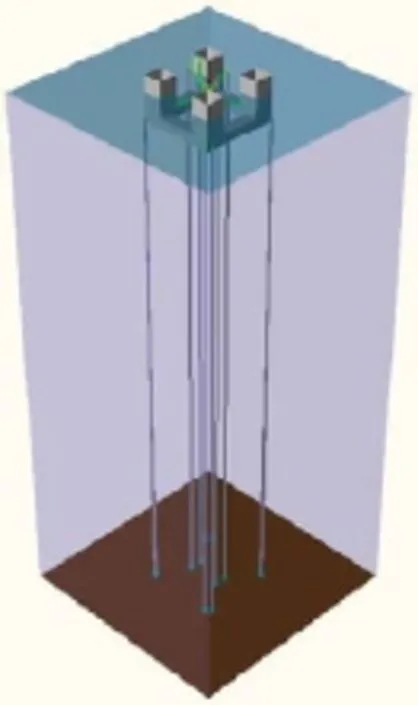
Fig.2 Numerical simulation model
2 Comparison of model test and numerical simulation for intact TLP
Compared with model tests,numerical simulation has the advantages of low cost,fast speedand without the effects caused by the scaled size.However,the validity of the calculation results depends on reasonable algorithm program,an accurate numerical model,and so on.In this paper,the results from the numerical simulation were compared with a model test,to verify its accuracy.The dynamic response of six degrees of freedom and varying tension of tendons of the TLP were simulated by software SESAM/DeepC and Patran-pre.The numerical model is shown in Fig.1.
The corresponding model test was conducted in the State Key Laboratory of Ocean Engineering of Shanghai Jiao Tong University.The size of the tank is 50 m×40 m×10 m(length× width×depth).The scaling factor of the wave height was 1:40 in the model test.The experiment model is shown in Fig.2.
2.1 Comparison of motion responses of intact TLP
Three cases D1H3,D2H4,D3H5 combined with different significant wave heights,significant wave periods and wave approach angles were selected to compare with model test results,as shown in Tab.2.
As shown in Tab.3,in all three selected load cases,the mean values of sway and surge response from the numerical simulation are close to the model test results with max deviation less than 0.15 m.And the difference of sway and surge maximum between simulation and test is a little larger.
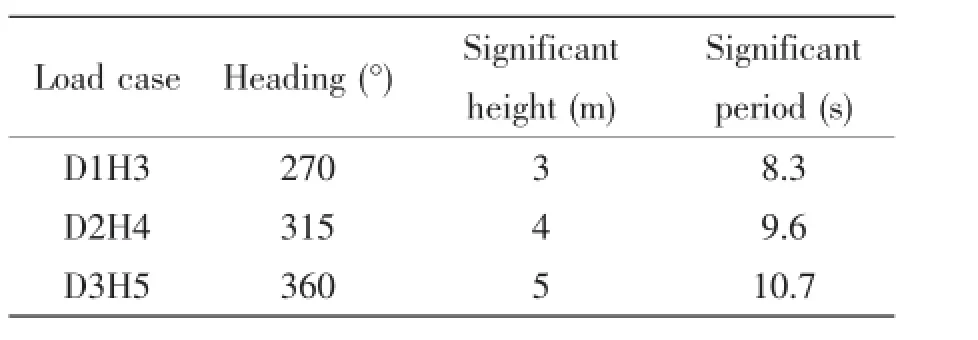
Tab.2 Load cases for comparison

Tab.3 Comparison of TLP motion
Figs.3-4 and Figs.5-6 respectively exhibit the time histories and the spectrum analysis of heave response by numerical simulation and model test in two typical load cases of D1H3 and D2H4.It shows that heave time histories show similar changing trend regardless of the usedresearch method.But the heave values from model test fluctuate in a wider range.The heave peaks by the two methods appear in the same frequencies near 0.1 rad/s,0.6 rad/s and 2.3 rad/s,indicating the two heave have the same sensitive frequencies.
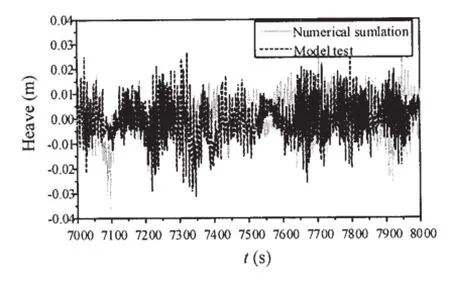
Fig.3 Comparison of heave times histories in D1H3
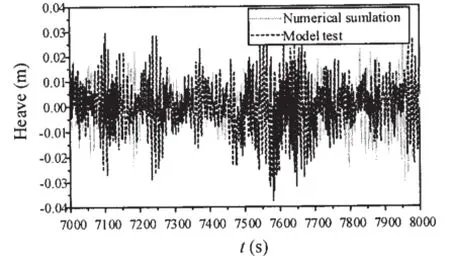
Fig.4 Comparison of heave times histories in D2H4
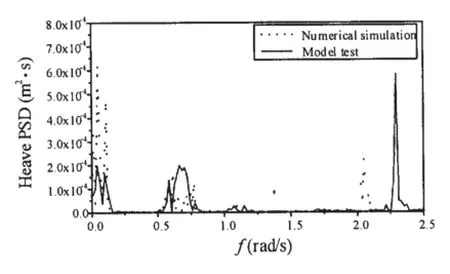
Fig.5 Comparison of heave PSD in D1H3
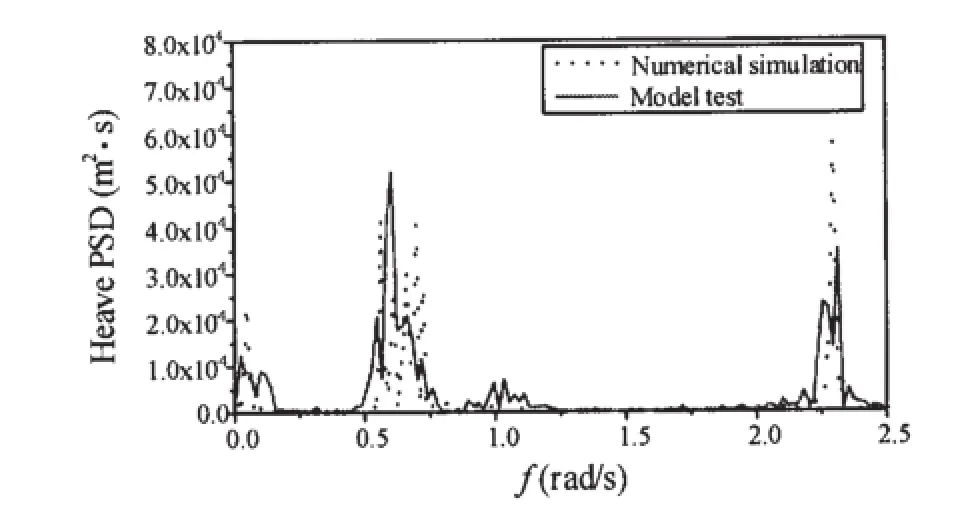
Fig.6 Comparison of heave PSD in D2H4
2.2 Comparison of tendons tension from numerical simulation and model test
The mean values,max values,standard deviations of the tendons tension respectively from numerical simulation and model test in load case D2H4 are listed in Tab.4.
As shown in Tab.4,the mean values of tensions from model test and numerical simulation are very close,with deviation less than 3%in Tendons1-4 and less than 10%in Tendons5-8 only.And the mean tensions from model test are smaller than those from numerical simulation. In addition,the max tension and tension standard deviation from model test and numerical simulation show the same distribution in Tendons1-8,as listed in Tab.4.Considering measurement error and effects of reduced scales in the model test,and the randomness of wave,the results using two methods are almost the same.

Tab.4 Tension of tendons from numerical simulation and model test
In D2H4,the max tension appears in Tendon7 and Tendon8,which is in head sea direction.So,the time histories and spectrum analysis results of tension in Tendon7 and Tendon3 are shown in Figs.7-8 for comparison,and Tendon3 is in the opposite of Tendon7.The tension PSD(Pulse Subtraction Doppler)spectrums are obtained by using the fast Fourier transform(FFT)method on the tension histories.The general trends of the tension spectrum from numerical simulation and model test are similar.And the tension peaks both occur between 0.6 rad/s to 0.8 rad/s.
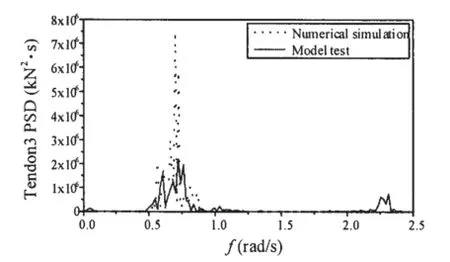
Fig.7 Tension PSD of tendon3 in D2H4
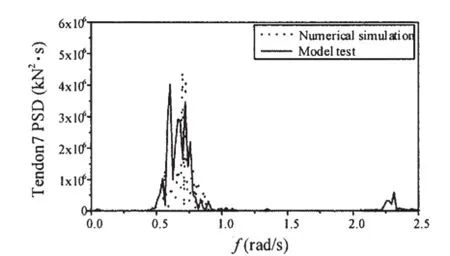
Fig.8 Tension PSD of tendon7 in D2H4
3 Motion response and tension of the TLP with one tendon broken
Once installed,the TLP will serve in the sea for a long time,it is very likely for the tendons to break in some harsh environment.Considering the symmetry of the TLP and the max tension position,combined with the above results,Tendon7 is assumed to be broken.The dynamic response and varying tension with Tendon7 severed are investigated and compared in more dangerous cases D2H5,D3H3 and D3H5.The effects of heading wave angles, significant wave heights and significant wave periods are discussed.

Tab.5 Load cases
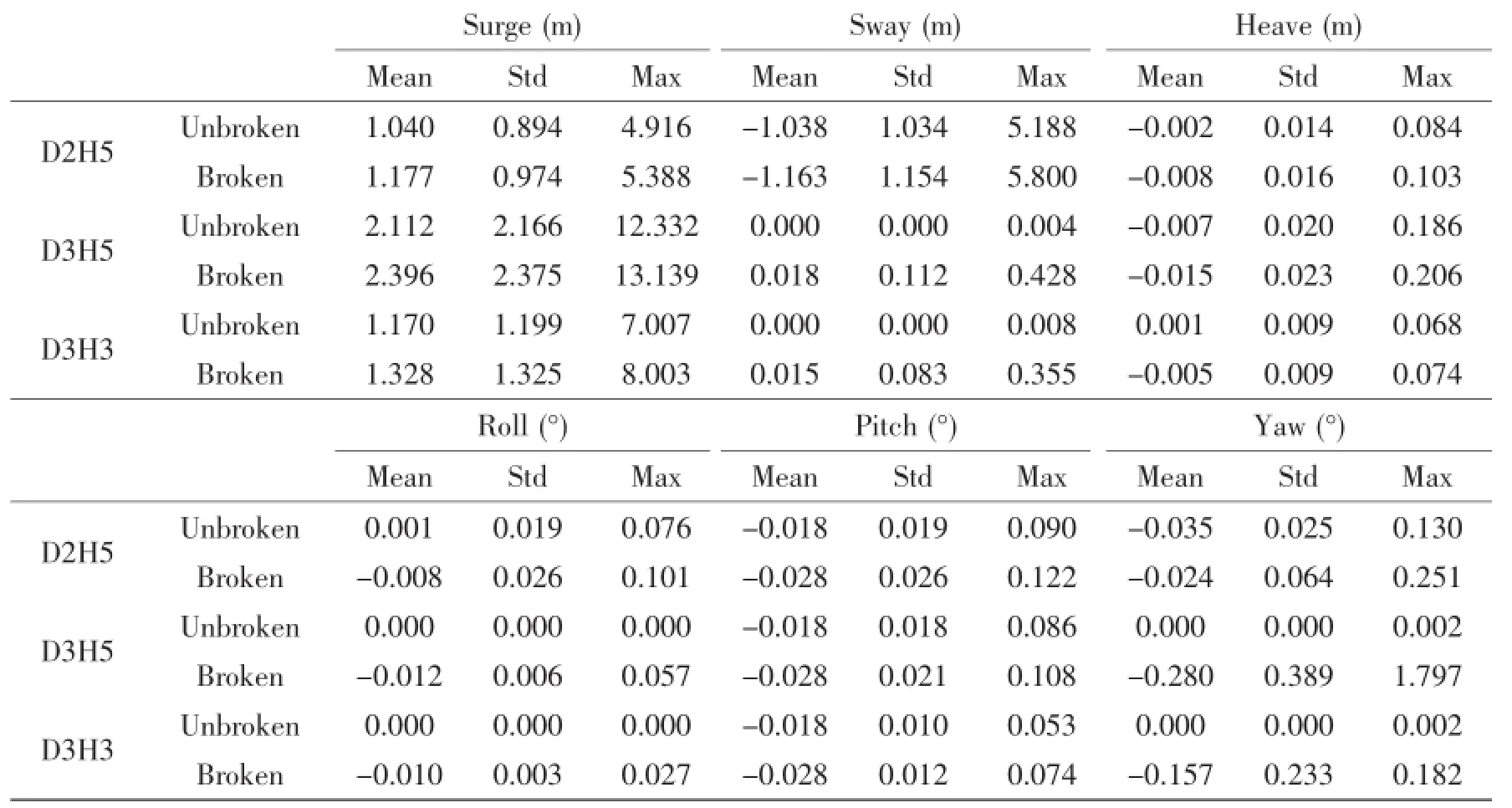
Tab.6 Motion response of TLP
3.1 Motion response of TLP with one tendon broken
The time histories of heave and sway of the TLP are shown in Figs.9-12 before and after Tendon7 is broken.With Tendon 7 severed,all of the mean,max values and the standard deviation increase.The growth has an insignificant relationship with wave approach angle andsignificant wave height.Considering the random of income wave,the growth of the max value is not as stable as that of the mean value and standard deviation.In D2H5,the Tendon 7 breakage causes the mean value,standard deviation and the max value of sway increase about 12%.In D3H3 and D3H5,the sway is almost negligible in intact condition.The breakage of Tendon7 breaks the balance of mooring system,as a result,obvious sway appears with max value about 0.3 m.

Fig.9 Sway time histories in D2H5
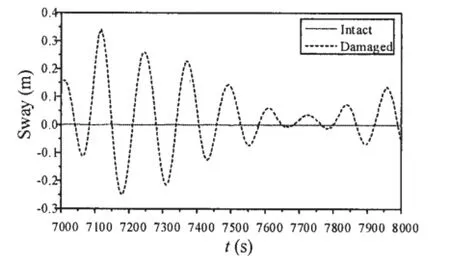
Fig.10 Sway time histories in D3H5

Fig.11 Heave time histories in D2H5
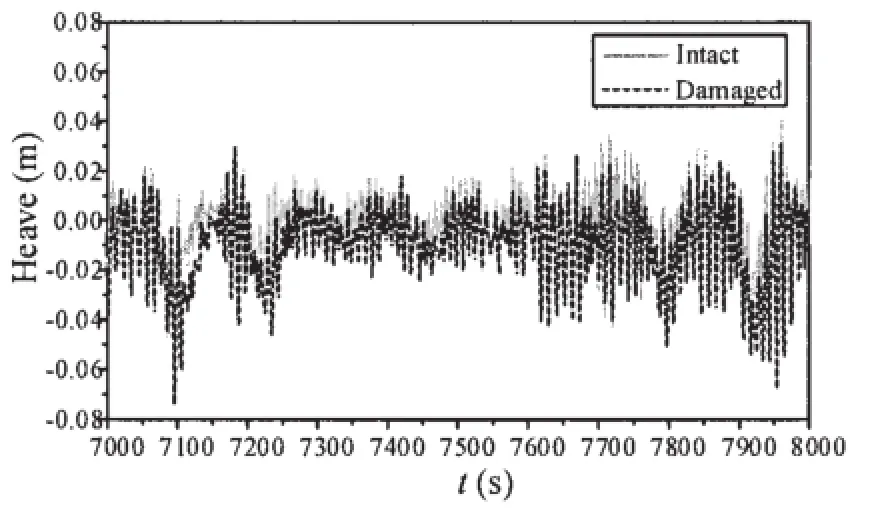
Fig.12 Heave time histories in D3H5
The breakage of Tendon7 makes heave response increase slightly with max growth not more than 0.2 m.As shown in Figs.11-12,the trend of heave response with Tendon7 is broken is almost the same with that of intact condition,which means that the breakage of Tendon7 has little impact on heave of TLP.The breakage of one tendon brings a small increase in the sway,surge and heave.
3.2 Tension of tendons in damage condition
Compared to the intact case,the tension of Tendon8 changes a lot with Tendon7 broken. As shown in its tension time histories,in the maximum tension of damages case is about the same with that of intact case,but the minimum tension of damages case is much smaller.So the tension fluctuation range increases significantly,which leads to fatigue damage for Tendon8 easily.The trends of tension PSDs of Tendon8 in the damaged case were nearly unchanged in D2H5,D3H3 and D3H5.However,the density at the same frequency increases about 2 times in the damaged case,which also indicates that the breakage of Tendon7 has a huge impact on the nearby Tendon8.On the contrary,as shown in Fig.13,the tension time histories of Tendon3 changes little in the damaged case,probably because Tendon3 is far away from the damage Tendon.

Fig.13 Tension time histories in D3H5(Tendon3)
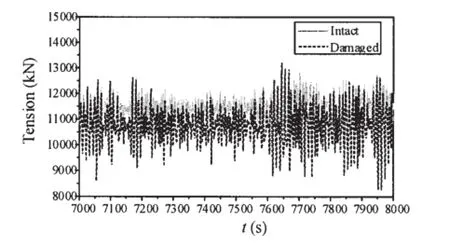
Fig.14 Tension time histories in D3H5(Tendon8)
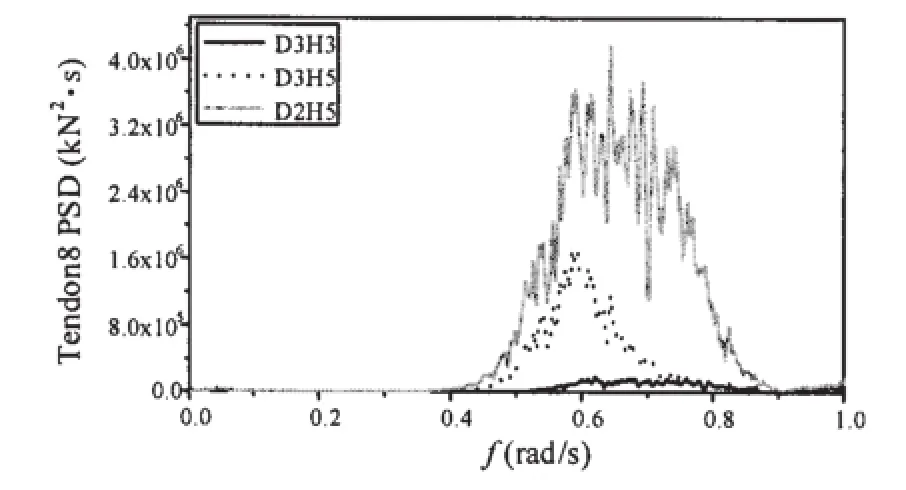
Fig.15 Tension PSD for intact(Tendon8)

Fig.16 Tension PSD for tendon breakage(Tendon8)
It has been observed from the Figs.17-18 that in D2H5 and D3H5,the breakage of Tendon7 results in similar variation in mean tension,with decrease of nearby tendons(Tendon1, Tendon2,Tendon5,Tendon6 and Tendon8),and increase of faraway tendons(Tendon3 and Tendon4).In addition,the mean tension in Tendon8 nearest to the damage tendon decreases most.So it can be inferred that the growth of mean tension is determined by tendons positions and with insignificant relationship on wave approach angle.
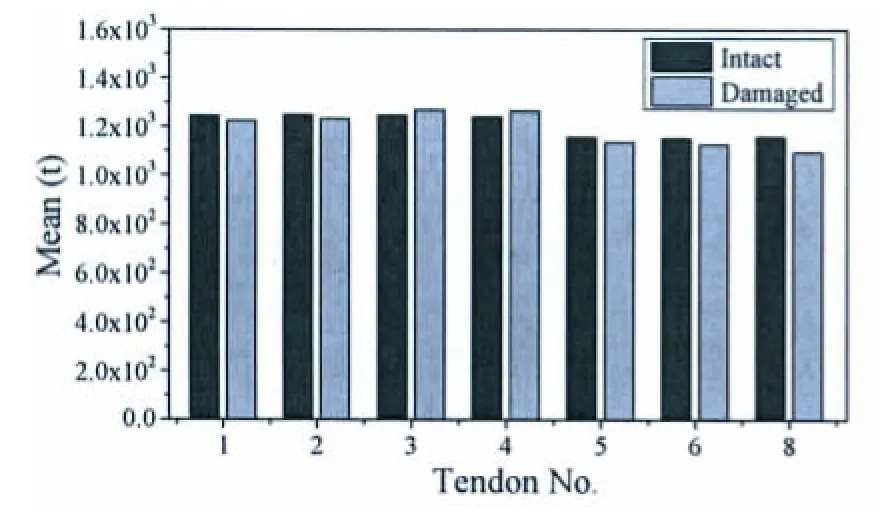
Fig.17 Mean tension in D2H5
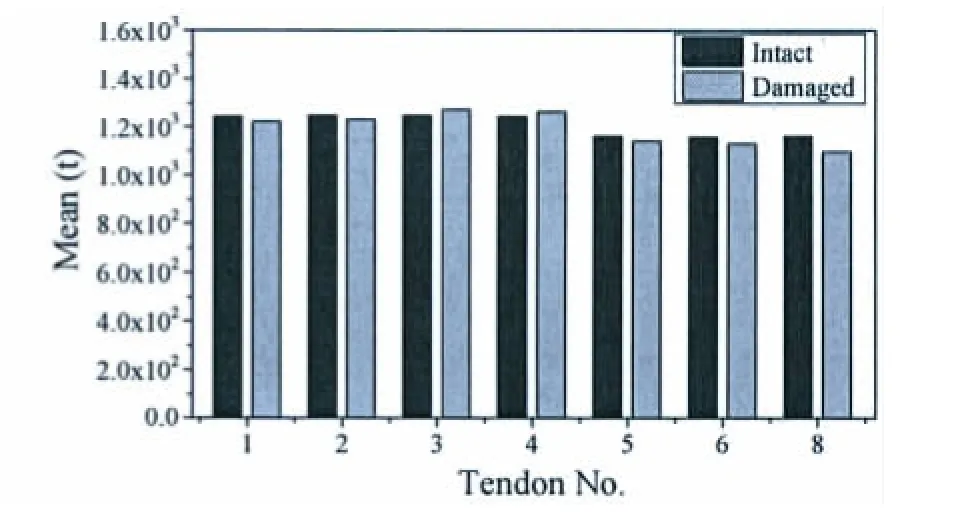
Fig.18 Mean tension in D3H5
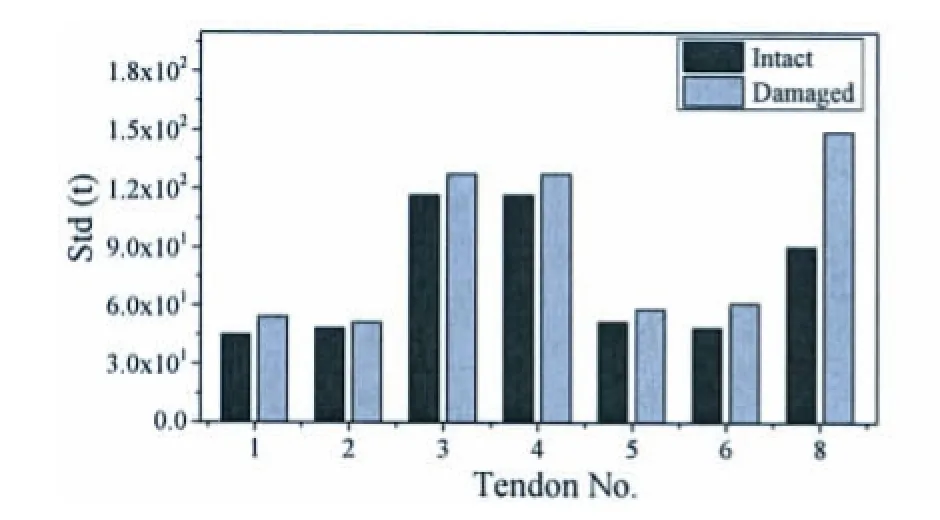
Fig.19 Std of tension in D2H5
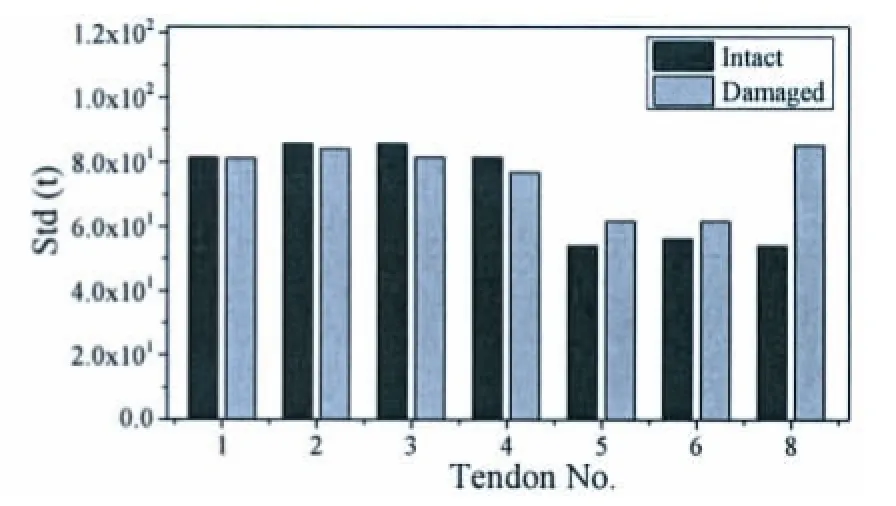
Fig.20 Std of tension in D3H5
The standard deviation of the tension is shown in Figs.19-20.In wave approach angle of 315°(in D2H5),the tendon breakage results in larger tension standard deviation with the largest growth in tendon8,indicating more volatile tension and greater fatigue-damage risk (see Figs.19-20).In approach angle 360°(in D3H5),the tendon7 breakage gives rise to positive tension standard deviation growth in nearby tendons,and negative tension standard deviation growth in faraway tendons.
In D2H5 and D3H5,with Tendon7 broken,the maximum tensions on Tendon3,Tendon4 and Tendon8 increase obviously(see Figs.21 and 22),with the largest growth in the nearest tendon(Tendon8).The growths of maximum tensions in 315°(D2H5)are larger than those in 360°(D3H5)in general.

Fig.21 Max tension in D2H5
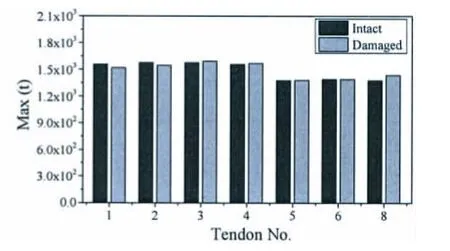
Fig.22 Max tension in D3H5
4 Conclusions
The nonlinear dynamic response and mooring system characteristic of a TLP in deep-sea are studied by the methods of model test and numerical simulation.Furthermore,the motion characteristics of TLP with one-tendon broken are investigated.The conclusions are drawn as follows:
(1)The motion response and tensions in tendons of an intact TLP by the model test and numerical simulation are compared and analyzed.Both the changing trend and the absolute value of motion and tension responses in time histories and PSDs are very similar,verifying the credibility of the numerical simulation carried out by the DNV software SESAM/DeepC.
(2)One-tendon-damage affects the motions of the TLP little.Both heave response and motion trajectories in XY plane in damage condition are almost the same with intact condition.The increases in the maximum value,standard deviation of the surge and yaw are about 10%,and the increase in the heave is less than 0.2m.The percentage increase in the rotation of the TLP is slightly larger,although the absolute value is very little.
(3)One tendon breakage results in decrease in the mean tension,increase in the maximum tension and increase in the tension standard deviation in nearby tendons,which suggest greater ultimate fracture and fatigue damage risk.The growth of mean tension is determined by tendons positions and with insignificant relationship on wave approach angle.In approach angle 360°(in D3H5),the tendon7 breakage gives rise to positive tension standard deviation growth in nearby tendons,and negative tension standard deviation growth in faraway tendons.The growths of maximum tensions in 315°(D2H5)are larger than those in 360°(D3H5)in general.
[1]Ahmad S,Islam N,Ali A.Wind-induced response of a tension leg platform[J].Journal of Wind Engineering and Industrial Aerodynamics,72,1997:225-240.
[2]Chandrasekaran S,Jain A K.Triangular configuration tension leg platform behavior under random sea wave loads[J].O-cean Engineeing,2002,29:1895-1928.
[3]Tabeshpour M R,Golafshani A A,Seif M S.Comprehensive study on the result of tension leg platform response in random sea[J].Journal of Zhejiang University,Science A,2006,7(8):1305-1317.
[4]Zeng Xiaohui,Li Xuanwen,Liu Yang,Wu Yingxiang.Nonlinear dynamic responses of tension leg platform with slacktaut tether[J].China Ocean Engineering,2009,23(1):37-48.
[5]Senjanovic I,Tomic M,Hadzic N.Formulation of consistent nonlinear restoring stiffness for dynamic analysis of tension leg platform and its influence on response[J].Marine Structures,2013,30:1-32.
[6]Yang C K,Kim M H.Transient effects of tendon disconnection of a TLP by hull-tendon-riser coupled dynamic analysis [J].Ocean Engineering,2010,37:667-677.
[7]Chandrasekaran S,Jain A K,Gupta A.Influence of wave approach angle on TLP’s response[J].Ocean Engineeing,2007, 34:1322-1327.
[8]Jain A K.Nonlinear coupled reponse of offshore tension leg platforms to regular wave forces[J].Ocean Engineeing,1997, 24(7):557-592.
[9]Gu Jiayang.Study on the complex dynamic response and vortex-induced motion characteristics of tension leg platform[D]. Shanghai:Shanghai Jiao Tong University,2013.
[10]Liu Weimin,Gu Jiayang,Lu Yanxiang.Research on dynamic response of different irregular wave factors on TLP[J].Ship Science and Technology,2014,36(7):58-63.
[11]Huang Jia,Xiao Longfei,Xie Wenhui,Kou Yufeng.Research on the mooring characteristics of deep water TLP[J].China Offshore Oil and Gas,2013,25(3):68-72.
[12]Gong Chao,Huang Weiping.The time domain analysis of a new type of ETLP under impact load[J].Ocean Engineering, 2015,33(1):24-30.
[13]Gu Jiayang,Wu Jie,Yang Jianmin.Study on transient structural dynamic response and mooring characteristics of TLP under impact load[J].Shipbuilding of China,2014,55(4):48-58.
一腱断裂下深水张力腿平台非线性动力响应及系泊特性研究
谷家扬,陈宇,耿培腾,刘为民
(江苏科技大学船舶与海洋工程学院,江苏镇江212003)
张力腿平台采用特殊的垂直系泊系统,属于半顺应半刚度式平台,平台主体-系泊系统-立管之间的耦合动力响应是张力腿平台设计的关键,直接影响平台的安全性和可靠性。文中首先采用数值模拟和模型试验相结合的手段对一座工作水深为500m的张力腿平台运动响应和系泊特性进行了对比验证,模型缩尺比为1:40,试验在上海交通大学海洋工程国家重点实验室进行,数值计算采用SESAM软件。在试验验证的基础上重点对一腱断裂的前、后平台水动力性能进行了对比分析,重点关注有义波高、特征周期以及浪向角等因素对六自由度运动响应以及张力腿张力特性的影响。
张力腿平台;耦合运动;一腱断裂;系泊特性
U661.43
:A
谷家扬(1979-),男,博士,江苏科技大学副教授,通讯作者,E-mail:gujayang@126.com;
1007-7294(2015)12-1488-10
U661.43
:A
10.3969/j.issn.1007-7294.2015.12.005
陈宇(1993-),男,硕士研究生;
耿培腾(1990-),男,硕士研究生;
刘为民(1979-),女,江苏科技大学讲师。
Received date:2015-11-02
Foundation item:Supported by National Natural Science Foundation of China(51309123);Jiangsu Province Natural Science Research Projects in Colleges and Universities(13KJB570002);the Open Foundation of State Key Laboratory of Ocean Engineering(1407)and“Qing Lan Project”of Colleges and Universities in Jiangsu Province,Academic Program Development of Jiangsu Higher Education Institutions(PAPD)
Biography:GU Jia-yang(1979-),male,associate professor,corresponding author,E-mail:gujiayang@126.com; CHEN Yu(1993-),male,master graduate student.
- 船舶力学的其它文章
- Active Control of Low-Frequency Sinusoidal Vibration Transmission of Ship Machinery
- An Analytical Model of Ballistic Impact on Light Ceramic/Metal Lightweight Armours
- Analysis on Factors Influencing Strains of Unbonded Flexible Risers Under Pressures
- Tensile Fatigue Test Method for Typical Stiffened Panel
- Theoretical and Numerical Research on CTOD for Ship Plate under Cyclic Loading Considering Accumulative Plastic Strain
- A New Concept of ETLP and Its Hydrodynamic Performance

